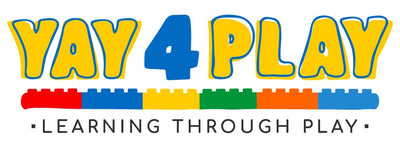Finding the perfect resources to enrich your classroom can feel overwhelming. But don’t worry, we've got you covered!
This article provides fresh perspectives and practical tips to help teachers in early learning centres, family day cares, and primary schools (K-1) choose versatile, budget-friendly tools that make learning through play a cornerstone of the school day.
For more ideas and cutting-edge teaching tools, visit Yay4Play.

Why Hands-On Learning Matters
Hands-on learning isn't just a buzzword—it's a transformative approach to education. At its core, there is the key notion of playful learning that has a lasting impact on core learning skills.
Other terms for this are experiential learning or explorative learning.
Engaging students with tactile activities enhances cognitive skills, fosters emotional growth, and encourages creativity. Overall, these amazing learning opportunities are at the very foundation of skills development and a way to prepare children for ongoing success at school.
Learn more about the benefits of these amazing resources here:
- By bringing hands-on experiences into their teaching practice, they cultivate an environment where students thrive through learning of concepts beyond pure academic learning. Even children with learning challenges and autistic children benefit from these hands-on tools.
- Hands-on learning allows students to actively participate in their own education, as opposed to passively absorbing information. This active engagement stimulates their minds and is a form of discovery learning
- When young children engage in hands-on activities, they use all of their senses to explore and interact with the world around them. This multi-sensory experience allows them to make connections and understand concepts at a deeper level. For example, when children manipulate objects like blocks or puzzles, they develop spatial awareness, develop fine motor skills, and learn about shapes and patterns.
- Moreover, hands-on learning provides opportunities for collaboration and social interaction in an engaging learning environment. By working together on a project or sharing materials, children learn important skills such as communication, cooperation, and negotiation - all critical aspects of child development.
- They also develop empathy and respect for others' ideas and perspectives: an important aspect of emotional development.
- Incorporating hands-on learning into the classroom also benefits children with different learning styles and abilities. It allows visual learners to see and manipulate objects, auditory learners to discuss and explain their thinking, and kinesthetic learners to engage their bodies in the learning process. By catering to diverse learning needs, hands-on activities create an inclusive and supportive environment for all students.
- At the same time, the added benefit is that these active learning opportunities help the achievement of curriculum learning as well. Certainly, a more fun-filled approach to reaching curriculum learning outcomes.
- Additionally, hands-on learning supports the development of important life skills.

More Benefits of Active Learning:
These active learning tools help educators create vibrant and dynamic learning experiences for their students. It makes this type of hands-on, experiential learning an essential part of holistic child development.
As a creative education team, you are able to use these hands-on activities to boost your classroom practice and see immediate results.
Hands-on learning can do all of this and more:
- Boosts cognitive development and the development of the brain for learning purposes
- Strengthens social skills and teamwork at all levels of development
- Enhances physical abilities
- Sparks creativity and imagination
- Develops perceptual skills as well as the development of ideas
- Builds emotional resilience
- Facilitates social interaction and group work
- Develops mental readiness
Top Tools for Engaging Learning
- Building Blocks and Bricks:
- LEGO® and DUPLO® type bricks: This versatile collection of bricks is perfect for developing fine motor skills, communication, and problem-solving abilities. For more activity resources, explore Yay4Play.
- Sensory Play Materials:
- Playdough, Sand, and Water Tables: These affordable resources are excellent for sensory exploration and help children understand different textures as part of their basic education journey.
- Storytelling Kits:
- Build-a-Book Series: This immersive experience combines storytelling with building, enhancing literacy and creativity. Discover more at Yay4Play.
- Educational Games:
- Board Games and Card Games: Games like memory match, counting games, and word puzzles are great for cognitive development and group activities.

Implementing Effective Teaching Tools
- Make Play a Daily Routine: Incorporate play into everyday activities to make learning enjoyable and engaging.
- Balance Independent and Group Activities: Encourage both solo and group play to support emotional and social development.
- Create an Inspiring Environment: Design your classroom to be a stimulating space where children can explore and learn.
- Partner with Parents: Share the importance of play-based learning and hands-on resources with parents and provide ideas for supporting it at home.
The Six Bricks Method as a hands-on resource
The Six Bricks method exemplifies our commitment to play-based learning. This approach uses six LEGO® DUPLO® bricks to create a variety of activities that support hands-on learning through play.
Here's why Six Bricks is a powerful teaching tool:
- Educational Value: Each activity targets specific learning objectives.
- Flexibility: Adaptable for a wide range of educational activities.
- Durability: Made from high-quality, long-lasting materials.
- Cost-Effectiveness: Offers great educational value at a reasonable cost.
- Engagement: Keeps students actively involved and motivated.
For more on the Six Bricks method, visit Yay4Play.

Final thoughts
Choosing the right educational tools is crucial for nurturing a love for learning and supporting comprehensive development in children.
By focusing on play-based, hands-on and flexible resources, you can create a stimulating and effective learning environment.
Visit Yay4Play for more innovative ideas and resources.
